What are bioplastics made from- Don't worry if your kids ask you one day what bioplastics are. This article will explain their definition and interesting facts, like the materials that make up bioplastics and their environmental impact.
I. How is bioplastic different from normal plastic?
First, we need to differentiate between bioplastic and ordinary plastic. Bioplastics are usually made from renewable resources like plant sugars. For example, corn is the primary source of this sugar in the United States. Cane sugar, sugar beets, wheat, and potatoes are used in other countries. Otherwise traditional plastics, on the other hand, are produced from non-renewable materials like cellulose, coal, natural gas, salt, and crude oil.
Related: What are some of the advantages and disadvantages of bioplastics
Bioplastics are used for various applications, including non-disposable carpets, plastic plumbing, phone cases, vehicle heat insulation, 3D printing, and surgical devices. Meanwhile, plastic containers, refillable water bottles, medical items, outdoor furniture, toys, suitcases, and automobile parts are some of the many everyday things that are produced using PP plastic (a type of traditional plastics).

Compared to normal plastics, bioplastics are renewable and better for the environment. There is a potential solution to the environmental and health problems caused by plastic trash. A recent study by americanoceans.org states that over nine billion tons of plastic have been manufactured, consumed, and discarded worldwide since the 1960s. As news of the plastic pollution of our oceans spreads, new alternatives to petroleum-based products have appeared.
Bioplastic's many advocates point to its environmental benefits, including lower carbon emissions and a shorter decomposition time. Traditional plastics typically contain the hormone disruptor bisphenol A (BPA), whereas bioplastic does not.
 Disposable packaging, containers, straws, bags, and bottles are made from bioplastics.
Disposable packaging, containers, straws, bags, and bottles are made from bioplastics.
II. What are bioplastics made from?
Bioplastics are now made from dozens of biological materials worldwide. PLAs and PHAs are the most widely produced bioplastics.
Polylactic acid, a thermoplastic polymer made from corn, potato, and sugarcane sugar, is PLA. PLAs are similar to polypropylene and polyethene and can be produced efficiently and cheaply using existing machinery. The second most common bioplastic after PHAs.
5% of global plastic production and consumption is PHAs. Polyhydroxyalkanoates are polyesters made by microorganisms from starch. PHAs can form plastics with over 150 monomers.
Due to their low cost, PLAs are used in food packaging and other consumer goods. Injection-molded PHAs are most often used in medical equipment.
1. Bioplastic from potato starch
Made from potato starch, "Potato Plastic" or Bioplastic from potato starch is a compostable material with a long lifespan. If it ends in nature, it will decompose into soil nutrients in two months. Uses for potato plastic are diverse and include cutlery, straws, and salt sacks. Because potato starch packaging can be made from byproducts of the food business, no new potatoes need to be planted. The energy required to produce it is also lower than plastic production. It is entirely biodegradable and has no oil-based materials, plastics, or harmful toxins. 
Potato starch is used to make the 'daily food bag'
2. Bioplastic from banana peel
At age 16, High school senior Elif Bilgin from Istanbul, Turkey, won an award at the 2013 Google Science Fair for her proposal to convert banana peels into bioplastic. Hence, Bioplastic, also known as compostable plastic, is proven to be manufactured from organic waste products like banana peels and other food scraps. There are no dangerous chemicals or toxic metabolites in them at all. Bioplastics, derived from starch-rich vegetable waste, can displace petroleum-based plastics.
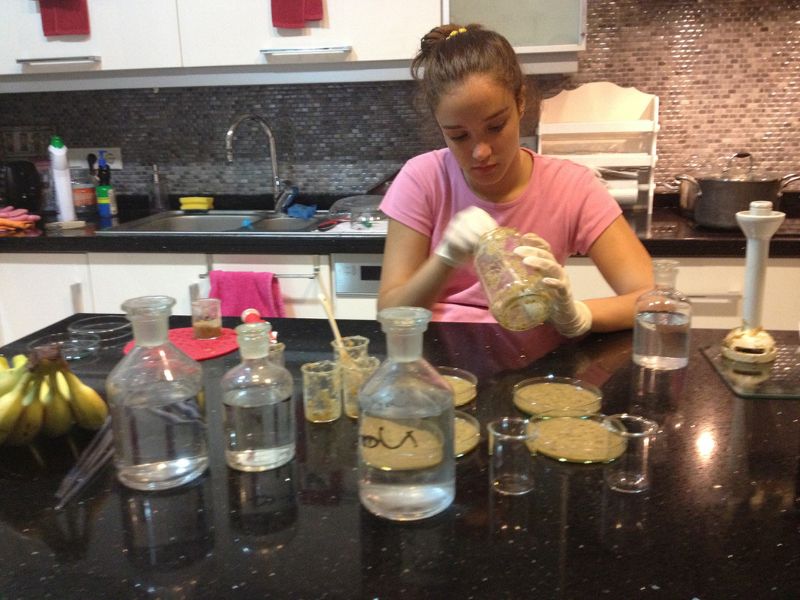
Bioplastic from banana peel is a science project of Elif Bilgin, a talented Turkish teenager.
3. Bioplastic from cactus
The University of Valle de Atemajac in Zapopan, Mexico, developed a biodegradable plastic from prickly pear cactus juice. The new material breaks down after a month in soil and days in water. Cactus juice sugars—monosaccharides and polysaccharides—form plastic. Sugars, pectin, and organic acids make the juice viscous. Because of the viscosity, it is possible to make a solid material.
4. Bioplastic from corn starch
Bioplastics made from corn starch were discovered to have properties comparable to commonly available packaging materials. By conducting tests, the bioplastics were also found to be soluble in water and degradable in soil, making them environmentally friendly. Is plastic made from corn starch capable of decomposition? Yes, it is both edible and biodegradable and does not impact the environment. How long does it take for plastic made from corn starch to biodegrade? In less than three months, PLA will break down into water and carbon dioxide when placed in an environment controlled for composting.
5. Bioplastic from milk
Is it strange to bring up the topic of bioplastic made from milk? That is correct. When the casein molecules in milk are heated and mixed with an acid-like vinegar, they can denature and reassemble themselves into a long chain. Each molecule of casein is known as a monomer, and the connected series of casein monomers is known as a polymer. Because the polymer can be scooped up and molded, plastic made from milk is called casein plastic.
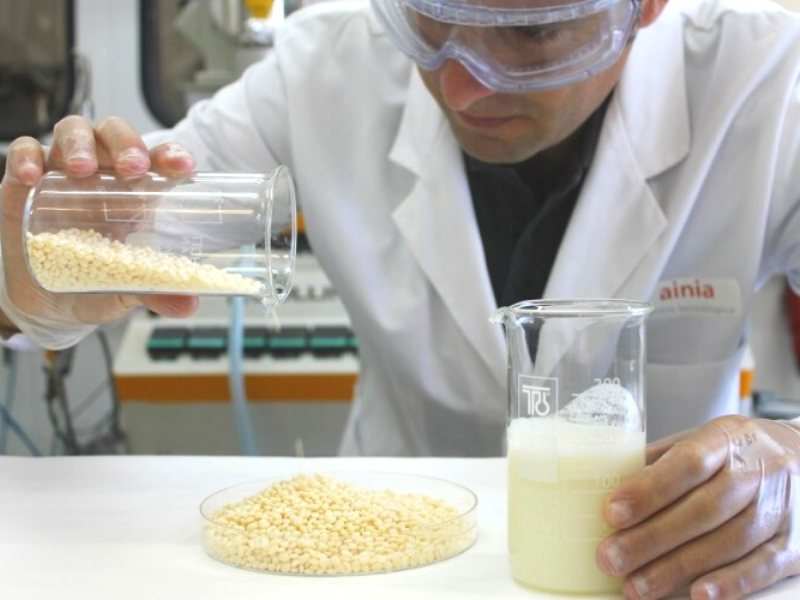 A scientist created a piece of bioplastic from cheese scraps.
A scientist created a piece of bioplastic from cheese scraps.
6. Bioplastic from seaweed.
As you may know, seaweed, also known as sea vegetables, is a type of algae that rises under the sea. They come in various colors, from red to green to brown to black, and serve as a food source for marine organisms. In addition, seaweed can be used to create bioplastic. Scientists employ a two-stage procedure to create seaweed bioplastic. First, sugars are extracted from the seaweed. Second, it undergoes a fermentation process in vats to form natural polyesters. A powder is what it appears to be. Microbes are responsible for making all of this possible.
The use of seaweed as a biomaterial has many advantages. Their biodegradability contributes to the fight against wasteful plastic. The carbon dioxide is also absorbed by seaweed. And they require almost no fossil fuels to cultivate.
7. Bioplastic from sugarcane
Plastic made from sugarcane is entirely biodegradable and recyclable. Sugarcane plastic, which is molecularly similar to regular oil-based plastic, is a fantastic environmentally friendly option that doesn't sacrifice quality standards. Bioplastics made from sugarcane are an excellent eco-friendly option for packaging. It lessens the need for nonrenewable energy sources like oil manufacturing plastic packaging.
8. Bioplastic from avocado seed
According to Forbes, a company in Morelia, Mexico, is turning agro-industrial waste into sustainable, biodegradable plastic. The company, BIOFASE, makes biodegradable silverware and straws out of avocado pits. Aside from being the first to be manufactured from entirely renewable and sustainable materials, the products are also extra durable, can be used with both hot and cold foods, and are environmentally friendly.
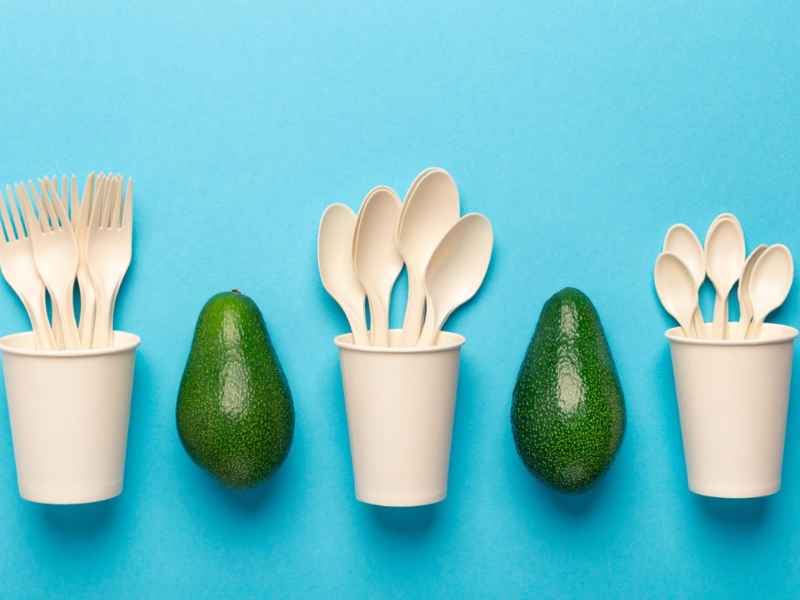 Bioplastic made from avocado seed
Bioplastic made from avocado seed
9. Bioplastic from chitosan
Chitosan can be utilized as a bioplastic capable of degrading naturally. Although it has many industrial uses, the most recent is as a biodegradable antimicrobial food packaging material; it has also been used in many other ways. To compete with conventional non-biodegradable plastic-based food packaging materials, a significant amount of research has been focused on chitosan-based convenient food packaging.
10. Bioplastic from eggshell
Shell Homage is a bioplastic made from eggshells invented by interior designer Rania Elkalla and won a green award in 2018–2019. Eggs are a kitchen staple, but their versatility is often overlooked. Her bachelor thesis on eggshells and nutshells began in 2010. She worked with material engineers to find a sustainable, biodegradable material that didn't rot. She initially reprocessed shells with synthetic resin. The material was beautiful and strong. Her process changed. Shells are sterilized, dried, and ground before disposal. This material is bonded with organic and biodegradable substances to create a production-friendly mixture. Drill, sand, or laser cut it like stone or ceramic.
11. Bioplastic from fish scales
Lucy Hughes, a British product designer, developed a bioplastic from fish scales. She says she had to wash everything she wore afterward, including her shoes, but the experience left her feeling motivated despite the unpleasant odor. She experimented with fish scales and skin to create a plastic substitute. It's made from recycled materials and can be broken down naturally.
To be clear, the fermented scales will go through cell disruption, washing, centrifugation, and drying to remove contaminants from the biopolymer. There will then be steps of cell distribution, washing, centrifugation, and drying involved in the biopolymer purification process. Making bioplastic is the final process.
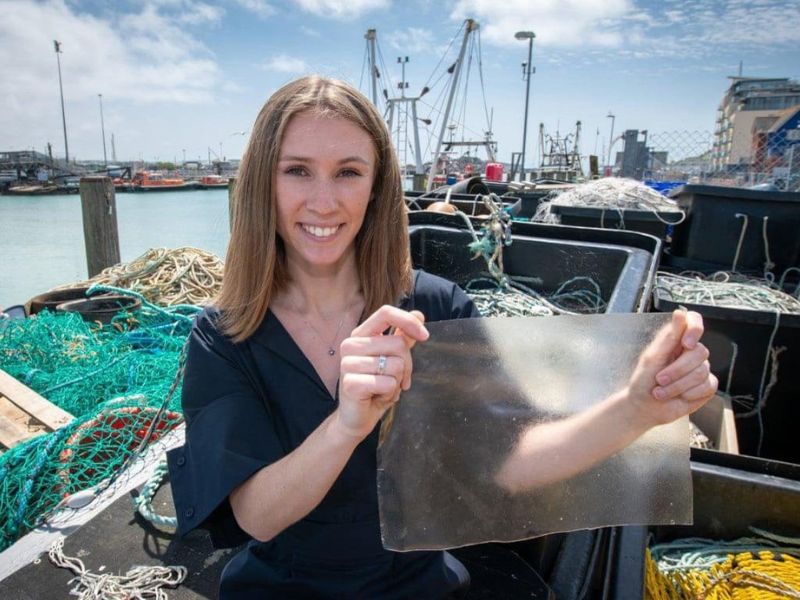 The British product designer Lucy Hughes created the bioplastic from fish scales.
The British product designer Lucy Hughes created the bioplastic from fish scales.
12. Bioplastic from orange peel
As an example of the circular economy in action, the Italian firm Carlo Ratti Associati has made an orange juice bar that turns waste fruit peels into cups made of 3D-printed bioplastic from the waste fruit peels. Because of its high cellulose content and easy availability, orange peel is the material of choice for this application. The bio-plastic film made from orange peel was manufactured in the laboratory using straightforward processes.
13. Bioplastic from rice
Finnish scientists have developed a biodegradable plastic made from rice starch that is durable and sustainable. The plastic is also transparent and has high mechanical strength and thermal resistance. This significant development in the direction of bioplastics derived from standard and renewable resources may find use in food packaging and biomedical materials.
Although it is a brittle polymer, starch can be made suitable for conventional plastic processing methods by subjecting it to heat and water, a process known as gelatinization. However, this method of film preparation results in films that recrystallize and degrade quickly, rendering them brittle and amorphous.
14. Bioplastic from shrimp shells
The scientists at Harvard University have developed a biodegradable plastic made from shrimp shells. Shrilk is a bioplastic derived from chitin, the main component of tough shells. According to the Harvard Gazette, the rigid, see-through material is already being molded into ingenious forms like egg cartons and chess pieces.
Furthermore, both raw and cooked shrimp shells can be composted. Microorganisms will do the heavy lifting of breaking down the shells, transforming them into nutrient-rich compost. It turns out that the compounds found in shellfish are also suitable for the soil's health.
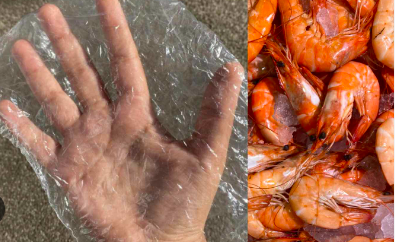
Bioplastic can be made from shrimp shells, so they are not as wasteful as we once thought.
III. The Bottom Line
Hopefully, the information provided here will serve as a helpful introduction to the bioplastics currently available. Feel free to contact us at any time, and a member of our team of experts will be available to assist you.
- Our Headquarter Address: A66, 3ha area, Phuc Dien Ward, Bac Tu Liem District, Ha Noi city, Vietnam.
- Email: info@europlas.com.vn.
- Website: https://europlas.com.vn/